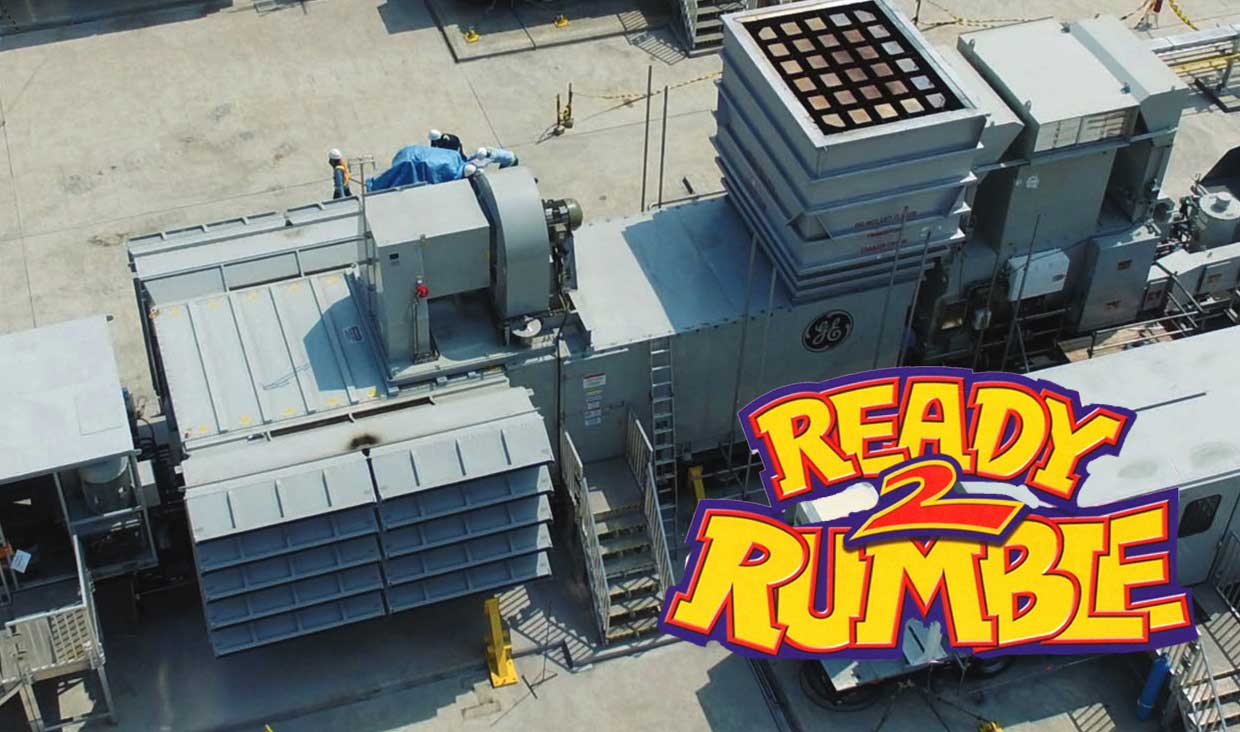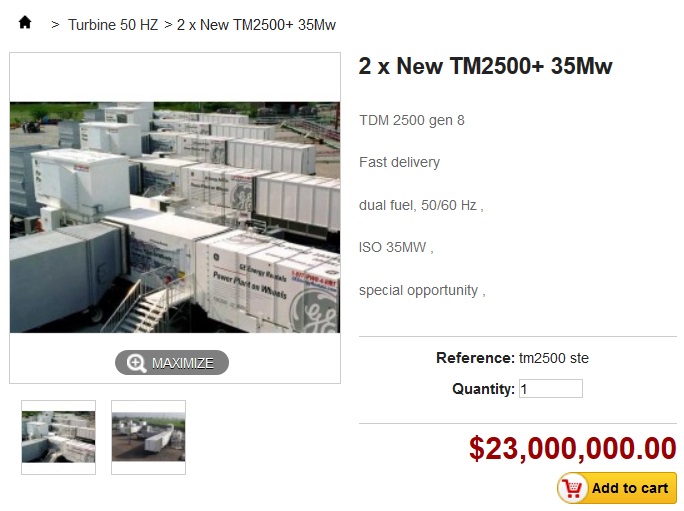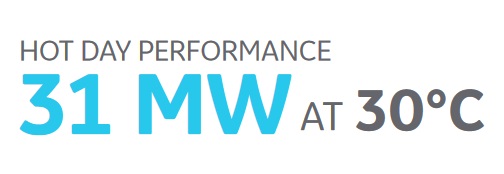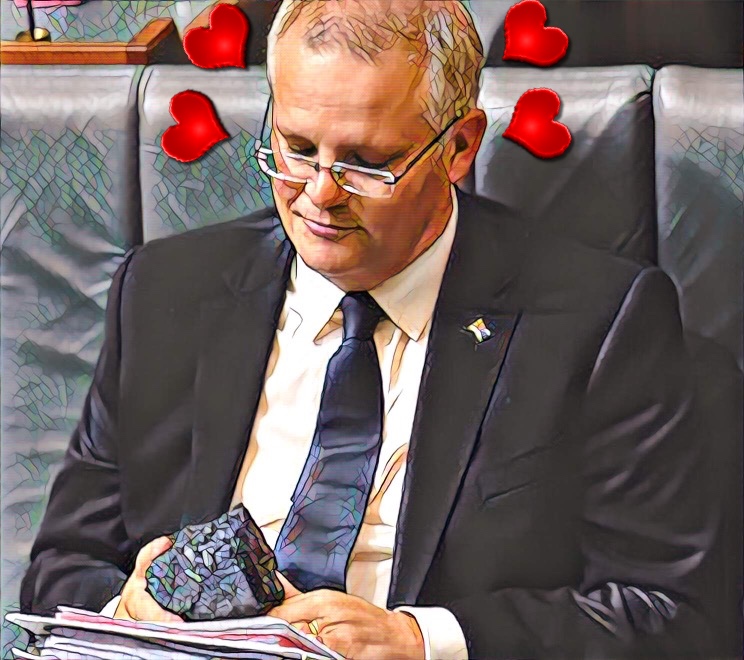
A General Electric TM2500 turbine generator yesterday. Or possibly earlier.
In order to improve the probability of South Australia making it through the summer without one or more blackouts, the state government has leased, with an eye to buy, 9 mobile General Electric TM2500 turbine generators.
According to their brochure they are able to supply a total of 309 megawatts of power — in winter. During a heatwave, which is when they’re most likely to be used, this will be reduced down to around 240 megawatts because the hotter it gets, the less efficient they are1.
For now they’ll be run off diesel, but next year the generators will be moved to a permanent location where they will use cheaper and and less filthy natural gas. Because of their relatively small size these turbines are capable of going from a cold start to full power in 5 minutes. A useful feature when it comes to reacting quickly to changing grid conditions. Because materials expand when heated, this warming up process can’t be skipped. If a small part breaks off things can rapidly go to pieces.
I expected the Coalition to be over-freaking-joyed that the South Australian government is buying fossil fuel powered generating capacity. But, despite the fact these turbines are capable of running off not one, but two fossil fuels, there are still members of the Coal Forever Brigade who are not happy. Leader of the state liberals, Vickie Chapman, said the plan to purchase the turbines was “scandalous” I really don’t know what it takes to please these people. Do the turbines have to burn diesel, natural gas, and coal all at the same time while directly farting flame onto the one remaining intact icecap before they’re satisfied?
I’ve seen people on the internet say the diesel generators are worse than coal power and they wouldn’t be needed if we had more coal capacity. Neither of these claims are correct. Diesel generation is less polluting than coal and for the purpose they are being used for the turbines are cheaper. There are diesel generators in states that produce the majority of their electricity from coal and coal heavy Victoria is getting some. Australia already has 650 megawatts of diesel capacity with another 473 megawatts of kerosene generating capacity for people who like their liquid fueled turbines to run off jet fuel.
They Cost Under $360 Million Dollars
The South Australian government hasn’t revealed how much the nine TM2500 turbines cost, but we do know they were under $360 million or $40 million each. But they’d better bloody well be under that much each because Sell Energy has two of them for a cool $23 million US dollars each.
That’s under $29 million Australian at the current exchange rate. I was tempted to get them both. If the South Australian ones are they same price, the nine will come to $260 million. But the state government has specifically said they got a good deal, so what could that be? Maybe $230 million? If so, that would be $745 a kilowatt. That’s not cheap as turbines go, but small, mobile ones cost more per kilowatt and have the advantages of being able to be quickly deployed and shoved where needed which saves on transmission costs.
How They Work
A General Electric TM2500 is a mobile power plant mounted on two trailers. The larger trailer has a turbine similar to a jet engine firmly bolted to it. This device truly sucks. It sucks, it compresses, and it blows. Rather than try to describe the magnitude of its suckage with words, I’ll instead show you this video by GE:
While I’d like to thank GE for making this video, I’m afraid it’s not perfect. But rather than waste your time pedantically going over the couple of things I found annoying, I’m instead going to hold a contest and let people try to guess what annoyed me in the comments. My good friend Al Pacino will describe what fabulous prizes are on offer:
Efficiency
GE says TM2500 turbines have an efficiency of 35.3% whether using natural gas or diesel. Unfortunately, that’s only when the air temperature is 15 degrees and they’re not likely to be needed in that sort of weather. If they function like large stationary turbines, then their efficiency during a 40+ degree heatwave should be around 31% or higher. Unfortunately they don’t function like them. According to their brochure, at 30 degrees their efficiency drops down to about 30%.
If I extrapolate that in straight line then in a 42 degree heatwave their efficiency will only be around 27.6%. This will lower their total capacity from 309 megawatts down to 241 megawatts. The good news is this is still well above the 200 megawatts of generation South Australia needed to meet the Australian Energy Market Operator’s (AEMO) reliability standard which allows only a moderate chance of a blackout over summer.
Pollution
Breathing diesel fumes is bad. Trust me on this. My IQ2 would probably be 20 or 30 points higher if I hadn’t huffed all that burnt diesel when I was slightly younger. In fact, if I hadn’t huffed it, I’d be almost smart enough not to huff diesel exhaust. Fortunately, these turbines burn diesel much more cleanly than the average truck does. Water is also injected in with the diesel to reduce the amount of noxious NOx produced.
But, no matter how bad burning diesel is, coal is worse. If you don’t believe me burn a chunk of coal and an energy equivalent amount of diesel and inhale the fumes from both and see which one makes you die less. Scott Morrison has some coal you can burn, but you might have to fight him for it. To the death.
CO2 Emissions
Including emissions from mining, generating one kilowatt-hour of electricity from coal in Australia releases around 1 kilogram of carbon dioxide into the atmosphere. When burning diesel in heatwave conditions, these turbines will generate just over 1 kilogram of CO2 per kilowatt-hour and in about one year when they are changed to burn natural gas they will produce around 810 grams per kilowatt-hour3.
Fuel Cost
Burning one liter of diesel releases 35.8 megajoules of heat. As the turbines should be about 27.6% efficient at converting heat into electricity and there are 3.6 megajoules in one kilowatt-hour, 1 liter of diesel will produce 2.7 kilowatt-hours of electricity. As generators don’t have to pay the fuel excise they can get diesel for around 90 cents a liter, which comes to a fuel cost of around 33 cents per kilowatt-hour. This is not cheap and is more than what most Australian households are charged per kilowatt-hour on their electricity bills. It is around 7 times as much as the current cost of generating electricity from black coal at its current high price of $130 a tonne.
They Will Rarely Be Used
Any coal fetishists reading this are probably currently coughing and spluttering at the high fuel cost of diesel generation. Even more than they normally do from all the coal smoke they are so fond of inhaling. But because these generators will only be used during critical periods to prevent blackouts, they may only operate on average for a few hours a year, so the high fuel cost isn’t much of an issue. This is especially true when the price of electricity during these critical periods is considered. When the grid is under stress the wholesale price of electricity is likely to be $14 a kilowatt-hour or potentially even higher. At that price a 33 cent fuel cost is only 2% of what the electricity can be sold for.
Why Not Use Them More?
If the fuel cost is around 33 cents and we assume operations and maintenance is another 2 cents per kilowatt-hour, then why not run these generators whenever the wholesale electricity price is over 35 cents and use them to make some money? The problem with this plan is, as far as I understand, the state government can’t. They have to assure the private generators they won’t compete with them and will only provide power to stabilize the grid and prevent blackouts. In other words, private companies are allowed to make money selling electricity while the state government is only allowed to spend money to keep the grid operating. But this isn’t quite as crazy as it may seem. If electricity demand is going to — almost — always be met, then some generating capacity is going to have to sit idle most of the time and having it belong to the government may be the best solution.
Why Diesel/Gas Turbines And Not Batteries?
While large scale batteries could be used to stabilize the grid and prevent blackouts, at the moment using fossil fueled turbines is much cheaper. Large scale batteries will still have to fall a long way in price before than can compete with diesel and gas turbines, but this may not be the case for home and business battery storage thanks to the extremely high cost of retail electricity.
Looking at the current cost of producing battery packs for electric cars, it is inevitable that home battery storage will start to pay for itself in Australia before long. If just 2% of South Australian households installed battery systems with 5 kilowatts of power and 10+ kilowatt-hours of storage each year, that would represent an annual addition of 66 megawatts of dispatchable power to the grid or more than what two TM2500 turbines can provide when it’s 25 degrees. In eight years households would be able to provide more power to the grid than Pelican Point, which is currently the second largest power station in the state.
What About Concentrating Solar Power With Thermal Storage?
The South Australian government has approved the construction of a 150 megawatt Concentrating Solar Power station with thermal storage 30 kilometers north of Port Augusta. It still remains to be seen if the federal government will approve a loan for its construction, but the price that Solar Reserve has given makes it appear competitive with new gas and coal capacity. Additional plants built after the first are almost certain to be even lower in cost.
So between home and business battery storage and solar with thermal storage, there may be little to no need for any additional fossil fuel generating capacity of any kind in Australia within just a few years.
These Nine New TM2500 Turbines May Never Be Used
It is now February and, apart from tests, the TM2500 turbines have never been used. While this month is, on average, the second hottest of the year in South Australia, it is quite possible the generators won’t need to be used at all this summer. But February is the hottest month for Melbourne and so it is possible their output will be needed to prevent blackouts there. And it’s always possible a coal power station anywhere from the LaTrobe Valley in Victoria to Gladstone in Queensland will have a major breakdown and the generators will be called upon to pick up the slack.
It’s even possible the new turbines will never be used. But while I can’t predict what will happen with them, there are some things I know for certain will occur for as long as the current mob are in Canberra:
- If the turbines aren’t needed they’ll be called a terrible waste of tax payer’s money and renewable energy will be declared a failure.
- If they are used and successfully prevent blackouts, because they were required renewable energy will be declared a failure.
- If the new turbines are unable to prevent blackouts from occurring, which is quite possible, then renewable energy will be declared a failure.
- If the new turbines are unable to prevent blackouts because one of Australia’s increasing unreliable coal power stations broke down, then renewable energy will definitely be declared a massive failure.
Footnotes
- The AEMO gives them a firm rating of 170 megawatts. This rating apparently assumes very hot conditions and 2 of the 9 units being non-functional. ↩
- My IQ is 160. I took an IQ test and got a result of 70, but because I finished in half the time I doubled it. ↩
- For diesel I included an estimate that 13% of its emissions result from its extraction, refining, and transportation and for natural gas I have assumed fugitive emissions equal to 1% of that total burned with a global warming potential equal to 25 times that of carbon dioxide. ↩




 RSS - Posts
RSS - Posts



I was the biggest fanboy of this idea and was hoping they went with 2 x LM6000 but the urgentness made the TM2500 or TM2500+ necessary.
However, the fact that they aren’t being used to avoid market caps is very disappointing. I agree, it is a very strange reaction by the COALition and the local Libs to fossil fuel generators.
I wonder how much the two cooling options would have added to the cost.
Anyone who owns a turbo charged vehicle knows the difference an intercooler makes.
I don’t know about you but the fact that the commentator called them turbans ten times was getting on my wick.
The fact that the narrator apparently thinks electricity is generated by rapidly spinning headgear is actually not one of the two things that annoyed me.
I’ll wait another day to see if anyone else wants a go at the fabulous prizes that aren’t on offer and then I’ll tell you.
Hi,
You need to use an Aust. dictionary for spell checking, “litre”, not “liter”.
Interesting article.
If only they could harness the hot air coming out of Canberra to generate electricity. But that’s probably due to a failure of renewable energy.
dRdoS7
I checked the Macquarie Dictionary and I see the Normans and their Latin endings have gotten to them too. Sometimes I really regret telling King Harold to keep an eye open for French arrows at the Battle of Hastings.
What a corrupt mob the SA State politicians are.!!
For all there rants about clean energy they for pure political survival with the SA elections coming up they put in place the dirtiest form of power generation to save their hides.
Unbelievable!!
Hello Colin
I’m very interested in hearing rants by the South Australian state politicians on clean energy, so please provide some links. Youtube links would be great.
AUD360 million, or AUD260 million, or some other figure? Knowing the business acument of federal and state governments of all political complexions, I believe it’s likely to be at the high end.
Why has the SA government not revealed how much it is paying for lease fees and what the purchase cost would be? Probably because it is embarassed by the amount of taxpayer dollars it has squandered in the pursuit of ideological purity.
It would be interesting if someone were to lodge a Freedom Of Information request to determine:
– the financial arrangements for these turbines
– how much taxpayers would have saved if the government had elected to keep the old coal fired Port Augusta station running for another couple of years (I heard it was just AUD20 million a year)
– how ma
Tried that once ~syphoning hot gas out of parliament, but the hose kept clogging up with all sorts of shit……
Can that be right??? –> ” My IQ2 would probably be 20 or 30 points higher”
….if you only got a 20-30 point increase by squaring your IQ, you’d currently have to be running on a quotient of -314……..
Okay, it’s time for me to reveal the the two things that I found annoying in the General Electric video on how gas turbines work. Rod had a good guess that I was annoyed at the way the narrator kept saying “turban” instead of turbine as if as if head gear were involved, but that actually didn’t really bother me. What I actually found annoying was:
1. The narrator said the turbine spins at over 3,000 rpm when we want to do pretty much 3,000 on the dot to generate electricity at 50 hertz. In the US they can do 3,600 to generate at 60 hertz, but I don’t recommend trying that here.
2. The graphics represented AC electricity as little flowing, glowing, blue balls. AC balls don’t flow, they wiggle back and forth 50 times a second. A wriggling wave would have been better.
Anyway, those are my petty, pedantic, nitpicks. And since nobody else played, our runner up Rod gets all the fabulous prizes! Of which there are none. So let’s hope Rod is very stoic. In fact, here, take this — it’s a stoic trophy…
I’m not an expert in this area, but I believe there may be some sense in SA’s diesel generators not being available for general power production, even when the wholesale cost is high. SA’s diesel generators are part of the AEMO’s RERT scheme.
What on earth is AEMO’s RERT scheme????
I’m glad you asked – I didn’t know about it either until I looked it up a coupla weeks ago.
AEMO is the Australian Energy Market Operator, and RERT is their Reliability and Emergency Reserve Trader scheme.
This is the scenario that AEMO is trying to deal with:
Suppose there’s a heatwave rolling through SA & VIC and the NEM (National Electricity Market) is just managing to cope with the load. And then a big coal generator crashes and suddenly there is just not enough power available in the network to meet demand. No spare power – the NEM is maxed out, and something goes crash.
Well – what would YOU do if you were the Australian Energy Market Operator? Do you just accept that brownouts happen and that’s OK?
So what AEMO has done is create RERT – additional ‘capacity’ that is not part of the normal NEM, but is available at short notice in times of crisis. Its intended to kick in when the NEM is ‘in extremis’ – when its at full capacity and something goes crash.
RERT is additional ‘capacity’ as its actually a combination of extra power generation, plus pre-planned load-shedding. Like a big steel plant or aluminium plant that has agreed under RERT to rapidly reduce its power needs. The list of RERT players is on AEMO’s web site and is interesting reading.
AEMO naturally tries to keep the cost of this extra capacity as low as possible, so it’s done by a tender process. Two tenders last year, another one closing in March this year. If you want to be a player in this, wurd is there’s a coupla GE turbines available for US$23million. Buy them, and put in a tender to be a RERT player.
I have no idea what the successful RERT tenders look like, but SA must be getting a payment for having their diesel/gas turbines available for emergencies. Could be a flat payment every day, could go up if the turbines are called upon as part of RERT. Given the SA Gummint’s lack of full transparency on any part of the turbine deal, we may not find out.
But that’s why the SA turbines can’t participate in the normal electricity market. If you’re ’emergency backup’ source is already being used in the main electricity market when things go kaput, then its not available to suddenly come into the market as ’emergency backup’.
The other reason for RERT being a separate ’emergency backup’, and only called on when the NEM is ‘in extremis’, is that it means the price signals to the market don’t get mucked up.
When there’s a heatwave, and the NEM is at maximum capacity, the wholesale price goes up, and potential new generators – i.e. solar and wind and batteries – use that high wholesale price as part of their decision about whether to build a new solar or wind farm. If you used the RERT to lower the wholesale price, that makes it harder for new operators to justify getting into the market.
When I say new players in the market, that doesn’t include coal. Has everyone noticed that professionals in the coal power biz are all on record that there will never be another coal power station built in Australia?? The only people still talking about ‘new coal power stations / clean coal / carbon capture & storage’ are people who are NOT professionals in the coal power business. Mostly they are politicians; sometimes they are op-ed writers in conservative media.
Thanks for that comment, Mark.
I don’t know the details of the South Australian government’s involvement in RERT or much about RERT itself:
https://www.aemo.com.au/Electricity/National-Electricity-Market-NEM/Emergency-Management/RERT-panel-expressions-of-interest
so, I didn’t go into it, but it appears to be a capacity market and what you’ve written jibes well with the little I know.
Looking at the list of RERT providers I see South Australia Power Networks (SAPN) is on the list for 170-270 megawatts of power:
https://www.aemo.com.au/-/media/Files/Electricity/NEM/Emergency_Management/2018/RERT-providers.pdf
And I presume that is the nine GE TM2500 turbines that are currently sitting around waiting for the grid to be stressed.
Ms Zibelman, CEO of AEMO, comes from the USA, and programs similar to RERT are in place in some areas.
When I read the list of RERT players, I was surprised to find so many ‘non-generating’ entities had signed up to be ‘load shedding’ players.
But for some big companies, it may be a pretty simple decision to load-shed. For example, if I run a company with a back up power system that costs $X/hour to run, I’m happy to drop out of the NEM if you’re gonna pay me $2X/hour to do it.